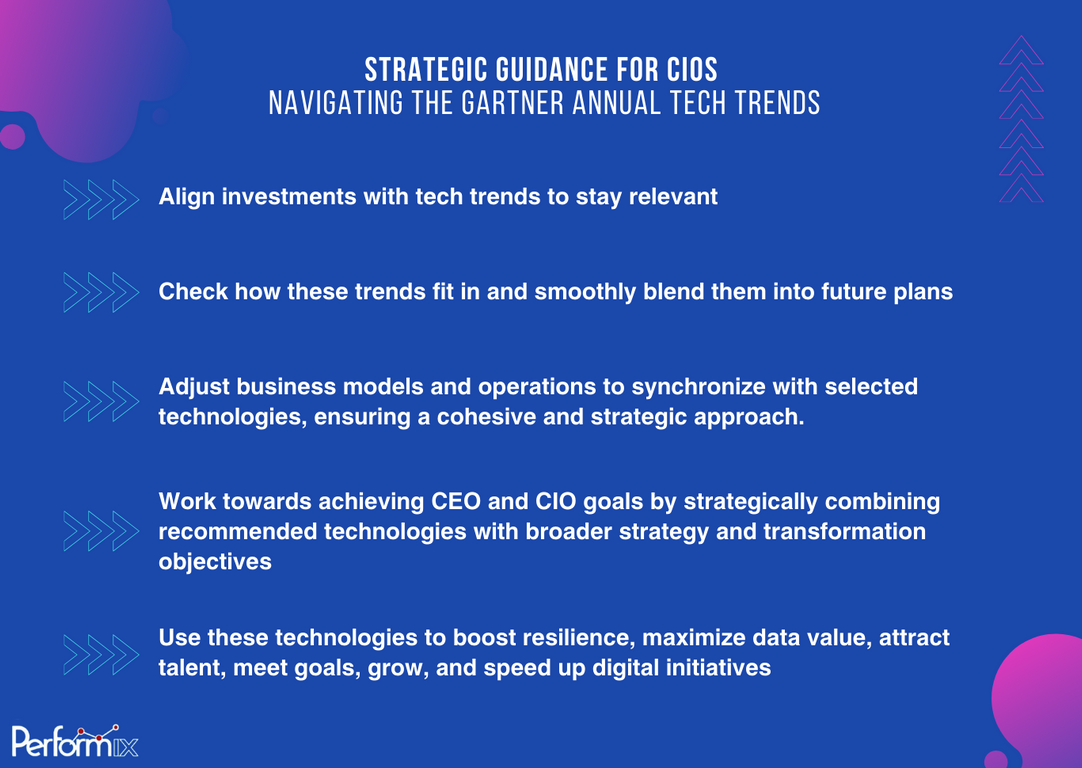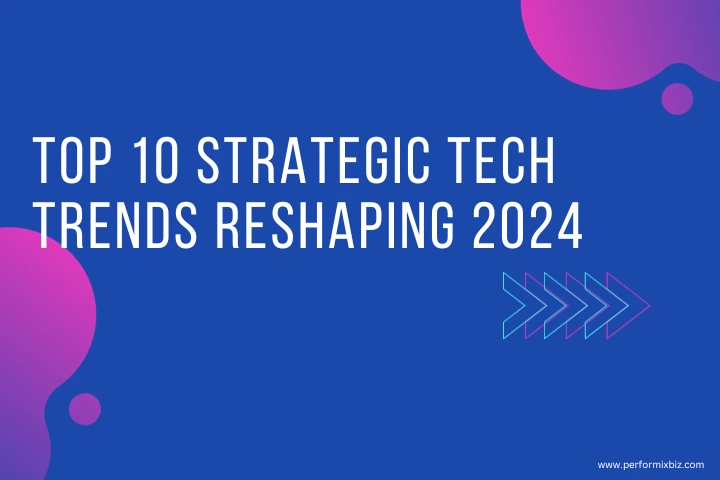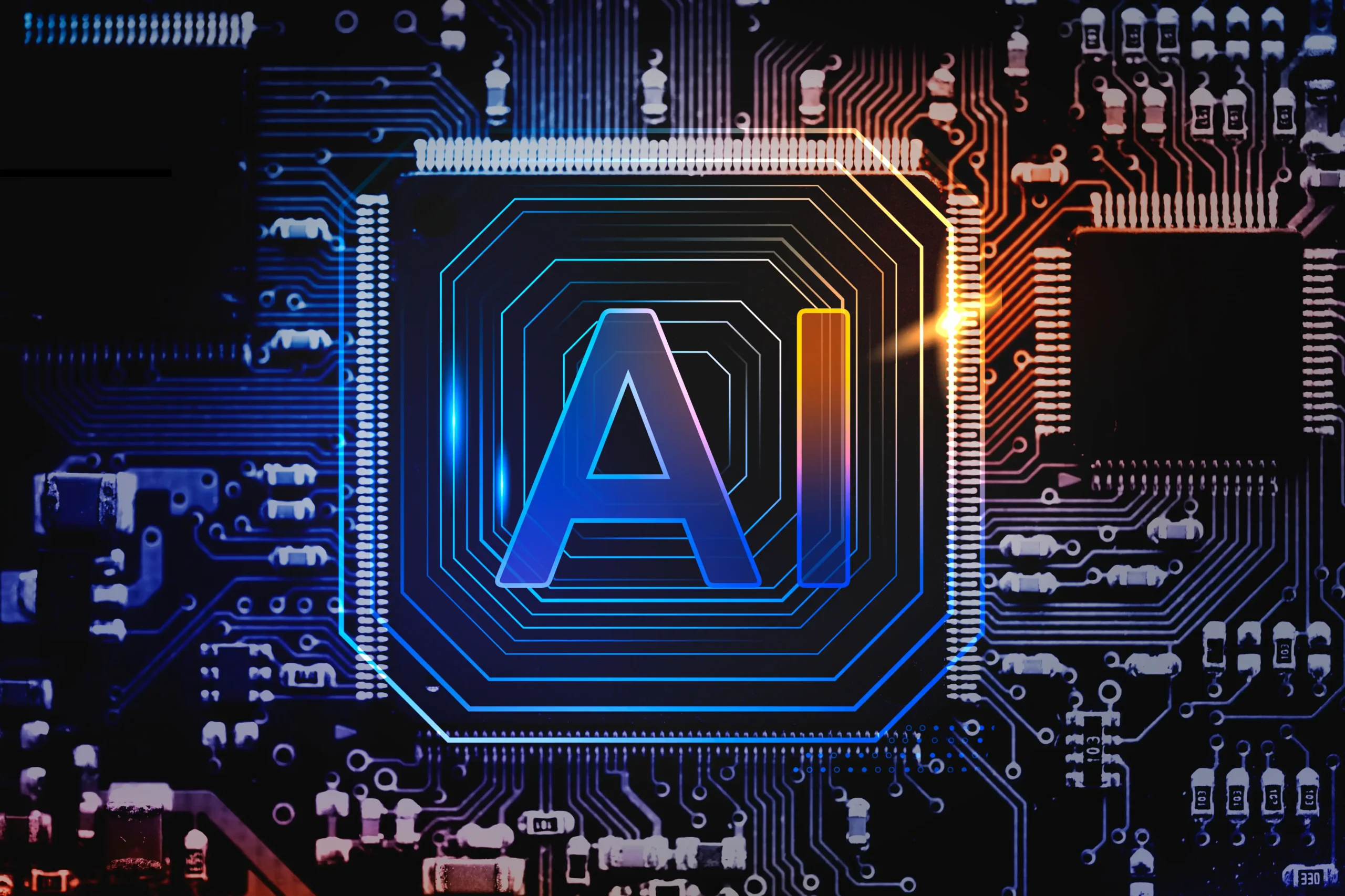Embarking on the technological frontier, 2024 is poised to witness groundbreaking innovations that redefine how we live, work, and connect. As we anticipate the future, here’s a glimpse into the top 10 strategic technology trends Gartner unveiled to reshape the landscape in 2024. These trends promise to influence critical business and technology decisions over the next three years, propelling organizations into a future of innovation and efficiency.
Let’s delve into a snapshot of each trend:
1. Democratized Generative AI:
Opening the doors to AI for everyone, this trend empowers non-experts to create and use AI models, revolutionizing design and development efforts for web and mobile applications. With its user-friendly nature and widespread availability, GenAI levels the playing field, democratizing access to information and skills across various roles and business functions. It stands as one of the most disruptive trends of the decade, promising to reshape how we work and innovate.
Impact of GenAI
- Productivity Surge: GenAI adoption means a substantial boost in organizational productivity.
- Conversational Knowledge: Large Language Models (LLMs) enable employees to access conversational-style knowledge.
- Effortless Development: GenAI supports a simplified “low-and-no-code” approach, empowering business technologists and citizen developers to customize easily.
- API Accessibility: GenAI tools are now available as APIs in the public cloud, simplifying application building for developers.
- Open-Source Benefits: Open-source models offer flexibility, control over security, privacy, and customization for aligning models with specific use cases.
2. AI-Augmented Development:
Accelerating software development through AI augmentation, this trend promises speed, efficiency, and precision in the creation of cutting-edge applications. Embracing AI as a software development partner requires shifts in the team’s operating model, culture, and skills to maximize its value entirely.
Seven Key Actions to Integrate Generative AI in Software Development
- Use generative AI code generation tools to write and understand software code.
- Deploy generative AI as an app modernization tool, but with caution due to the risk of factual errors.
- Use generative AI to detect and measure technical debt and its impact, but avoid using it for remediation or tracking.
- Meet user expectations for AI-powered products and services, particularly in providing conversational prompt-based interfaces.
- Leverage AI across the software testing life cycle for improved efficacy and faster delivery times.
- Take seven actions as software engineering leaders to embrace AI as a partner, including instilling an AI-first mentality and upskilling the team.
- Recognize that shifts in the team’s operating model, culture, and skills are necessary to maximize the value of AI in software development.
3. AI Trust, Risk, and Security Management:
While Generative AI has generated significant interest in AI pilots, organizations frequently overlook potential risks until AI models or applications are actively in production or use. A robust AI Trust, Risk, and Security Management (TRiSM) program enables you to incorporate essential governance measures from the outset, proactively ensuring AI systems adhere to compliance standards, fairness, reliability, and safeguard data privacy.
Six Compelling Reasons Why AI TRiSM is Indispensable:
- Lack of Understanding: The widespread inability to explain AI and its workings creates a knowledge gap among managers, users, and consumers.
- Open Access to AI Tools: Accessibility to generative AI tools, like ChatGPT, by anyone introduces new risks that traditional controls may not effectively address.
- Confidentiality Risks in Third-Party Integration: Integration of third-party AI tools may lead to risks in data confidentiality, with users potentially accessing sensitive data within others’ AI models.
- Continuous Monitoring and Risk Management: AI models and applications demand ongoing monitoring and specialized risk management processes to ensure compliance, fairness, and ethical use.
- Adversarial Attack Prevention: Detecting and preventing malicious attacks on AI necessitates novel methods and technical controls.
- Emerging Regulatory Frameworks: Regulatory frameworks, such as the EU AI Act, are being established to manage AI risks, requiring robust compliance controls.

4. Intelligent Applications:
Intelligent applications powered by AI hold the potential to elevate customer experience and foster product loyalty. These apps provide adaptive, automated, and augmented experiences by learning from user interactions.
Instances of Intelligent Applications:
- Property Insurance Apps:
These apps autonomously file claims based on real-time data, such as weather and satellite information. They may also offer discounts to policyholders in low-risk periods.
- Dynamic Pricing Models:
Driven by machine learning and contextual understanding, these apps employ dynamic pricing models. Prices are adjusted in real-time considering demand, availability, and customer preferences.
- HR Employee Self-Management App:
This app streamlines user experience based on usage patterns by offering shortcuts and personalized recommendations. For instance, it could provide shortcuts for compliance training and performance review updates.
These examples illustrate how intelligent applications streamline processes, enhance decision-making through machine learning, and tailor experiences to individual user needs, resulting in a more efficient and personalized interaction.
5. Augmented-Connected Workforce:
Augmented Connected Workforce integrates technology like automation and AI, fostering efficient collaboration and data-driven decisions. Emphasizing adaptability to customer demands ensures controlled access to evolving digital tools. Implementing this approach enhances productivity, elevates customer experiences, and fuels innovation, creating a connected and agile workforce. In essence, it’s about leveraging technology to empower employees, enhance efficiency, and deliver value to stakeholders.
6. Continuous Threat Exposure Management:
In the dynamic realm of cybersecurity, attackers move quickly, prompting organizations to automate controls and deploy patches reactively. A Continuous Threat Exposure Management (CTEM) program is essential to address future exposure proactively. This program identifies threats and prioritizes those with the highest risk to the business, requiring a streamlined five-step process.
1. Identify Entry Points:
Identify vulnerable entry points and assets, encompassing traditional devices, apps, and intangibles like social media accounts and supply chain systems.
2. Expand Discovery Process:
Implement a thorough discovery process beyond the initial scope to unveil visible and hidden assets, vulnerabilities, and misconfigurations.
3. Prioritize Threats:
Prioritize threats based on urgency, security, compensating controls, residual attack surface tolerance, and overall organizational risk. Focus on high-value assets with a treatment plan.
4. Validate Attack Scenarios:
Confirm the exploitability of vulnerabilities, analyze potential attack pathways, and assess the response plan’s effectiveness. Define triggers for remediation.
5. Mobilize Teams:
Communicate the CTEM plan to security and business stakeholders, ensuring understanding. Mobilize teams to operationalize findings, streamline approval processes, and document cross-team workflows.
These steps aim to continuously identify and prioritize threats, validate defenses, and mobilize resources to minimize the exposure to cybersecurity risks.
7. Machine Customers:
Virtual customer assistants powered by AI take customer interaction to the next level, providing personalized recommendations and enhancing the overall customer experience. Business leaders with digital acumen can take five actions today to attract machine customers and tap into their substantial purchasing power. Implementing these strategies becomes crucial as this demographic expands and evolves into more discerning and autonomous decision-makers.
The five ways to court AI-enabled machine customers are:
- Make all your product and service information easily accessible to AI-powered customers.
- Add machine customers to your core digital commerce and sales strategy.
- Develop a robust commercial partnership between sales, marketing, supply chain, IT, and analytics.
- Start hiring and training sales and service staff to work with AI agents.
- Alert and train customer-facing staff to spot machine customers.
These strategies aim to appeal to machine customers, accommodate their unique needs, and maximize revenue potential.

8. Sustainable Technology:
AI has great potential for societal benefits but poses environmental challenges. To enhance sustainability, adopt efficient AI systems, monitor energy usage, and prioritize eco-friendly hardware. Consider environmental impacts in AI strategy, focusing on positive use cases. Balancing AI for sustainability and the ecological effects of AI itself is crucial. A sustainability-aware approach to AI adoption ensures alignment with broader sustainable goals.
Here are five strategies for developing more sustainable AI:
1. Human Brain Efficiency:
Embrace composite AI structures mirroring the human brain’s efficiency for enhanced problem-solving.
2. Energy Monitoring and Optimization:
Monitor and optimize energy consumption during machine learning, using federated machine learning for localized data training and energy-efficient hardware.
3. Optimized Workload Management:
Balance AI workloads based on local energy supplies’ carbon intensity, utilizing energy-aware scheduling and forecasting to reduce emissions.
4. Renewable Energy Procurement:
Secure power purchase agreements (PPAs) or renewable energy certificates (RECs) to offset emissions and introduce renewable energy strategically.
5. Environmental Impact Integration:
Model environmental impacts alongside business benefits, prioritize value-driven use cases, enhance energy efficiency, and avoid potentially damaging AI investments.
9. Industry Cloud Platforms:
Industry or vertical cloud platforms combine software, platform, and infrastructure as service capabilities to provide tailored solutions for different industries. These platforms offer industry-specific features and functionalities, accelerating cloud adoption and enabling rapid adaptation of processes and applications. By 2027, over 70% of enterprises will use industry cloud platforms. These platforms create value by offering adaptable and relevant industry solutions and fostering ecosystem collaboration. To fully leverage the benefits, a broad set of stakeholders in IT and the line-of-business organization must embrace industry cloud platforms.
10. Platform Engineering:
Platform engineering is an emerging trend in software delivery that aims to optimize the developer experience and accelerate product teams’ delivery of customer value. It involves creating and maintaining an engineering platform that provides standard, reusable tools and capabilities for software developers and others. This platform is designed to enhance user experience and productivity while promoting consistency and efficiency for the organization. By 2026, 80% of large software engineering organizations will have platform engineering teams. Developing new tools has made platform engineering a hot topic in DevOps.
Preparing for 2024
As we stand on the cusp 2024, the horizon is ablaze with the promise of transformative technologies. Gartner’s revelation of the top 10 strategic technology trends casts a compelling vision of innovation and efficiency for the years ahead. From democratizing AI to navigating sustainability challenges, these trends beckon organizations to chart a course into the future. As we delve into each trend, from intelligent applications to continuous threat exposure management, it becomes evident that today’s choices will shape tomorrow’s digital landscape. The journey into 2024 is not just about technology; it’s a voyage into a realm where innovation meets resilience, and organizations wield the power to redefine how they work, connect, and thrive in the evolving technological frontier.






